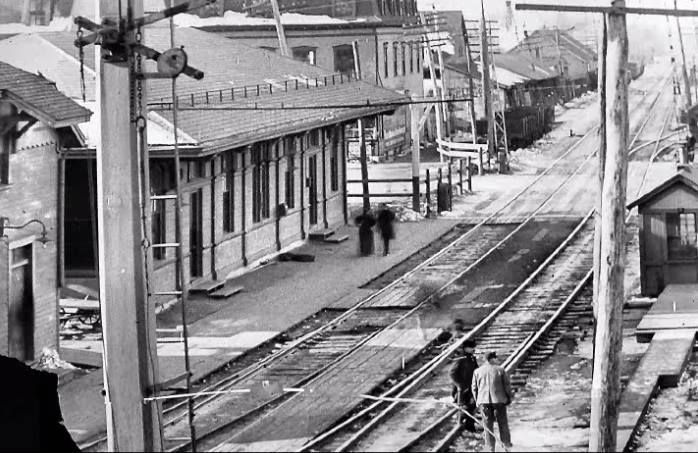
Shoemaking started in Natick in the 1830s. H.P. Harwood &
Sons pioneered the “figure eight” modern baseball in 1858, in the first baseball factory in America. Today, Natick is a dynamic retail, research, and computer services center.
Business and Industry in Natick:
Historical Highlights
The American Industrial Revolution materialized in Natick in about 1830 when entrepreneurs started making shoes. The first railroad line stretching west from Boston arrived in Natick in 1835. It immediately stimulated business and industry in Natick, and the town's commercial and industrial activities became more centralized.
Shoe-Making
After a few years of scattered entrepreneurial activity, by 1835, shoemaking in Natick had developed into a "putting out" or cottage-type industry. At that stage in the early 19th century, the shoes were handmade. Leather shoe pieces were cut by hand and then farmed out to the independent “cordwainers” who finished the shoes in their "ten footers," the small shops that stood behind many houses in the town. The Henry Wilson shoe shop is an authentic example on West Central Street, near Mill Street.
Factory runners dropped off piece-work throughout the town and picked up the finished shoes for shipment by Howe's Express to the trains, ships, and wholesale houses in Boston. The shoes made in Natick were primarily heavy work shoes, although one or two companies offered lighter dress shoes at different times. Natick was famous for its "brogan," a simple, inexpensive leather shoe shipped in substantial quantities to plantation owners in the American South who bought them for the enslaved people who worked on the plantations.
19th-century “cordwainers” in their “ten-footer” workshops. Image source: Unknown
The Pfeiffer Shoe factory on Water Street - the last shop in South Natick (closed during the 1930s Depression), date unknown. Image source: Unknown
The growing shoe and boot industries attracted many service and support businesses. There was a tannery at the west end of Summer Street on Pegan Brook near Lake Cochituate. The Natick Box and Board Company supplied shipping boxes (originally, the boxes were hand-built until Charles Coombs, the owner, developed the first box-cutting machine.) Large wagons were needed to ship the shoes and boots, and many of these were made in the shop of J.D. Macewen, whose company manufactured and painted carriages, sleighs, and wagons: two other companies—O. Woods & Company, William Bruce and Son—began producing wooden cases that held 12 to 40 pairs of boxed shoes.
The advent of the sewing machine radically changed the manufacture of shoes. Natick’s shoemaking flourished during the mid-1800s and peaked by 1880, when the town, with 23 operating factories, was the third-largest shoe producer in America. By 1928, the town’s shoe output had diminished by half. In 1971, the Winchell Shoe factory on Cochituate Street, the last of over 40 shoe producers in Natick, closed its doors.
Baseball Manufacturing
H.P. Harwood & Sons baseball factory
Natick was the birthplace of modern baseball and the site of the first baseball factory in the United States.
In the 1850s, two young ballplayers in Natick, John W. Walcott and William A. Cutler, pioneered important new baseball-making methods. While Walcott designed a more resilient inner core, consisting of hard rubber wrapped in glue-soaked yarn, Cutler designed the well-known “figure eight” stitching pattern that remains the gold standard in baseball about 170 years later. It is no coincidence that both Walcott and Cutler were shoemakers by trade and had considerable experience working leather into rounded shapes.
Local businessman Harrison P. Harwood quickly saw the opportunity in Walcott and Cutler’s work. He bought the pattern and, in 1858, opened the first baseball factory in the United States. Harwood baseballs quickly became a standard for officially organized games. The building that housed H.P. Harwood & Sons still stands at 12 Walnut Street, just north of the center of town.
In the earliest days of the sport in America, baseballs typically had a core wrapped with yarn and covered in leather or sheepskin, stitching around the circumference described as a “lemon-peel” style. The core was a small rock or a variety of other small objects. This early version of a baseball was lighter and softer than the modern ball to suit the game as played at the time. As the game evolved in the mid-1840s, the rules of organized play changed to require a harder baseball that better matched the changing style of the game. At the same time, baseball construction was switching to a ball with a rubber core wound with yarn and covered with leather. In 1872, the National Association of Baseball Players required a ball to weigh at least five and not more than five ¼ ounces, with a circumference of at least nine and not more than nine ¼ inches. Today’s Major League Baseball rules specify the same weight range and a circumference of 9 ¼ inches. One early version of the baseball had been covered with cowhide. Harwood’s best balls were covered with horsehide, and a less expensive ball was produced with sheepskin. Harwood built a tannery east of Sawin Street at what was then called "Tannery Pond." The pond, which many called “Stink Pond,” became such a blight in the neighborhood that the tannery was discontinued.
In the early production years, Harwood baseballs were wound in the factory, and stitching on the covers was outsourced to Natick women working in their homes. These "League Balls" were sold nationwide and in Canada. H.P. Harwood & Sons prospered through three generations of family ownership and closed in 1988.
Grandmother’s Mincemeat
More than 100 years ago, some enterprising food companies were active in Natick. Aubrey Foster made peanut butter in his Summer Street building in the town center. In about 1920, Dr. Ewald G. Baum, Leonard Morse Hospital's first surgeon, was the inventor and manufacturer of a patented "Kap Seal" for milk bottles—this twist-on cap covered the lip of the bottle to keep the contents fresh. In 1899, Harrison L. Whipple started making “Grandmother’s Mincemeat.”
In a back room of The Whipple Company’s grocery store, Whipple started commercial production of his famed mincemeat using the time-tested recipe of his grandmother, Mrs. Sophia Tuttle. He used her image in early advertising promotions for “Grandmother’s Mincemeat.”
Lewis E. Whipple, Harrison’s son, took over the business in 1908 and began expanding the range of products to include several kinds of fruit-based pie filling and preservatives, jams, syrups, and more under the “Grandmother’s” brand. New recipes for different flavors of mincemeat were introduced to keep up with changing tastes. Still, the original recipe from Sophia Tuttle was never abandoned as “Grandmother’s” products grew in popularity.
The Whipple Company absorbed several other local food companies, including A.A. Knights in 1960 and the producers of Bostonia Brand Soda Fountains in 1962. Throughout its existence, Whipple maintained its central production factory in Natick, although the operation was relocated several times as the company expanded. In 1947, the last location was established on North Main Street. The Whipple company was a famous Natick enterprise for over 100 years until it was sold in December 2003.



